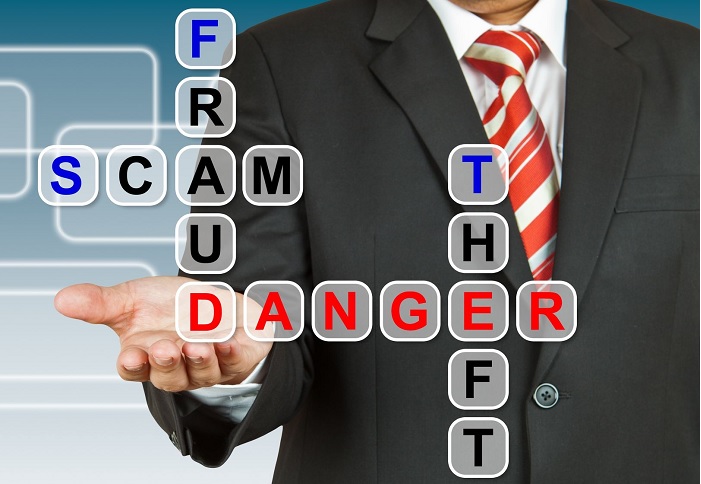Small Businesses lose a crippling amount of money each year to fraud. Learn to place proper controls in your business and annually assess your fraud risk. Here’s how.

How Annual Assessments Can Prevent Fraud in Your Business
Small businesses lose a crippling amount of money each year to fraud due to a lack of awareness of the risks or a lack of seriousness in dealing with them. To prevent fraud in your business, you need to know how and why it occurs to put the proper controls in place.
What would happen to your business if it suddenly lost $150,000? A loss of that magnitude could cripple many businesses. Yet, based on cases that were actually reported, that is the median loss suffered by small businesses in 2018. For many businesses, a loss that large would sound alarms. However, employee fraud tends to occur over time, making it less noticeable and, therefore, more devastating. On average, small businesses lose six percent of their annual revenue to fraud – a rate of loss few enterprises can withstand.
While small businesses are more vulnerable to fraud than big companies, it’s not entirely due to a lack of resources – although that does play a part. The primary reason is their lack of awareness of fraud risk. Even with minimal resources, small businesses can effectively mitigate fraud risks when they know how and why it occurs.
How Fraud Occurs
It’s probably no surprise that most fraud occurs within the financial functions of a business, specifically in the areas of employee expenses, procurement, and payroll.
Expense reimbursement: An employee inflates his expenses with fake travel activities or by increasing the amount of expenses.
Business credit cards: Employees using business-issued credit cards to pay for personal expenses.
Procurement: An employee creates a purchase order for goods or services and then diverts them for personal use; or an employee creates a phantom vendor account, through which fake invoices are processed with funds paid to the employee as the phantom vendor.
Payroll fraud: It could be as simple as an employee padding his time log to receive overtime payments or a payroll staffer creating a phantom employee with fake time logs.
Knowing where and how fraud could occur in your business is the first step. The second and more critical step is to gain a clear understanding of your business’s specific fraud risks.
Assessing Fraud Risk in Your Business
The type and level of fraud risk can vary from business to business depending on its size, structure, and industry. The only way to identify your business’s vulnerabilities is with a fraud risk assessment that should be conducted at least once a year. A fraud risk assessment should involve your management team, Board of Directors, and an audit committee or a Certified Public Accountant. Larger businesses should engage a Certified Fraud Examiner who can guide the assessment while assisting in developing internal controls.
While it is an investment of your time and resources, consider the return on investment for preventing the loss of $150,000.
Conducting a Fraud Risk Assessment
A thorough fraud risk assessment is an end-to-end process that begins with identifying risks and leads to developing responses and controls. The process should be ongoing with periodic monitoring and assessment of control effectiveness. Here are the critical components of fraud risk assessment:
Identify potential fraud risks or schemes. In addition to the more common schemes described above, consider all internal and external vulnerabilities specific to your business.
Probability of occurrence. Rank the likelihood of occurrence from highly unlikely to a near certainty and the frequency of occurrence from rare to very frequent.
Impact on the organization. For each fraudulent activity, rate its financial impact on the organization from incidental to catastrophic.
Identify existing fraud prevention controls. List the internal controls used to prevent or detect specific fraudulent activities.
Assess the effectiveness of existing controlsfrom ineffective to high effectively.
Propose corrective actions.Propose additional controls to cover newly discovered risks or improve existing controls.
Assign responsibilities. Assign development, implementation, and monitoring of controls to appropriate personnel.
Assessment review: Schedule regular reviews of your fraud risk assessment to include a reassessment of potential risks and the effectiveness of internal controls.
Implement Fraud Prevention Procedures
Most small businesses have limited resources to address all their risk exposures. The assessment will tell you where you need to act first – based on the probability of occurrence and the impact on the organization. Many of the controls can be procedural, which might only require a reallocation of some resources.
Preventative procedures can include periodic surprise audits, fraud education and training, and establishing and communicating a code of conduct. Detective procedures could consist of establishing a fraud hotline for employees, customers, and vendors, along with reporting mechanisms. Fraud response procedures are the corrective actions taken immediately to minimize damage, including a coordinated approach to investigation and remedial action protocols.
Communicate Your Fraud Policy
One of the more effective ways to reduce fraud is to develop a formal fraud policy and communicate it to all employees. It should also be shared with vendors and customers who can play a crucial role in fraud prevention. Companies that spend more time talking about fraud with their employees tend to experience less of it.
Recent articles:

Building Strategic Partnerships for Small Business Success - Strategic partnerships amplify reach, reduce risk, and accelerate growth—proving small businesses go further, faster when they build together.

Embracing Micro-Influencer Marketing for Small Businesses - Micro-influencers give small businesses authentic reach, higher engagement, and real sales—proving that trust, not size, drives modern marketing.

Using Financial Software to Streamline Small Business Bookkeeping - Automating your bookkeeping saves time, reduces errors, and gives you real-time insights—so you can focus on growth, not data entry.

Using Data Analytics to Drive Small Business Decisions - Data analytics empowers small businesses to make smarter decisions, cut costs, improve marketing, and stay competitive in today’s fast-paced market.

The Rise of Hybrid Work Models for Small Businesses - Hybrid work helps small businesses attract talent, save costs, and stay competitive, making flexibility a key driver of growth in 2025 and beyond.

Financial Planning for Seasonal Businesses - Seasonal businesses can thrive year-round by mastering cash flow, budgeting, and tax planning, turning challenges into lasting growth and stability.
Previous Articles:
- Crafting a Realistic Cash Flow Forecast for 2025: A Guide for Small Businesses
- Elevate Your Business with Flexible Payment Options for Customers
- Understanding and Optimizing Your Business Credit Score
- The ROI of Automation: Affordable Tech Solutions for Small Business Growth
- High-Impact, Low-Cost Marketing Ideas for Small Businesses
- The Small Business Owner’s Guide to Managing Stress and Avoiding Burnout
- With Credit Tightening, How Small Businesses Can Build a Strong Financial Profile
- Post-COVID Trends That Small Businesses Can’t Afford to Ignore
- Standing Out in a Saturated Market: Tips for Small Business Differentiation
- Tightening the Belt: 10 Cost-Cutting Strategies for Small Businesses Facing Rising Expenses
- Five Steps Small Businesses Can Take to Increase Web Traffic
- Retention 101: Keeping Your Best Employees in a Competitive Market
- Creative Ways to Overcome Labor Shortages in Your Industry
- Preparing Your Business for the Next Recession: Actionable Tips
- 2025 Tax Updates for Small Businesses: What You Need to Know
- Email Marketing Mistakes Businesses Must Avoid
- Why Community Engagement is Crucial for Small Businesses
- Adapting to E-commerce: A Guide for Brick-and-Mortar Stores
- Harnessing the Power of Customer Reviews to Boost Your Business
- Small Business Owners Need an Integrated Approach to Post-Pandemic Financial Planning
- How to Build a Strong Brand Identity on a Budget
- The Future of Remote Work: Tips for Small Businesses to Thrive
- Navigating the Gig Economy: Opportunities and Challenges for Small Businesses
- Sustainable Business Practices: How Small Businesses Can Make a Big Impact
- 10 Essential Free Tools for Small Businesses
- 7 Ways Small Businesses Can Benefit from AI and Automation
- How to Leverage Social Media for Your Small Business in 2024
- The AI Advantage: How Small Businesses Can Thrive in the Age of Intelligence
- Shielding Your Business: Essential Insurance for Risk Management
- How Outsourcing Can Help Your Small Business Grow
- Securing Your Data: A Cloud Security Checklist for Small Businesses
- Mastering Cash Flow: How Banks Empower Small Businesses with Cash Management Tools
- Optimizing Productivity for a Remote Workforce
- Digital Strategies: The Engine of a Virtual Distribution Strategy
- Attracting and Engaging Gen Z: The Future of Your Workforce
- Managing Cash Flow for Business Prosperity
- How to Position Your Bank as a Trusted Advisor for Small Businesses—And Why It Matters
- Business Owners Need a Complete Risk Management Plan
- Preparing Your Business to Borrow
- Is Your Business Prepared for Generation Z?
- Small Business Trends You Don’t Want to Miss in 2024
- Ideas on How to Improve the Customer Experience
- Do You Use Website Analytics to Learn About Your Customers’ Interests?
- 5 Strategies to Incorporate into Your Business for 2024
- The Benefits of Mobile Banking and Remote Deposit Capture
- Should You Have a Blog on Your Website?
- Best Practices for Protecting My Business Online
- Using ACH to Improve Cash Flow
- 10 Ideas to Help You Recruit New Talent
- How AI Could Improve Your Business
- Using a Small Business Loan to Expand Your Services
- Local, State, and Federal Resources for Your Business
- Security Essentials for Keeping Business Data Safe
- Leveraging Your Bank’s Cash Management Services to Improve Your Business
- When is the Best Time to Obtain a Business Loan?
- How Much Insurance Do I Need for My Business?
- Incorporating the Latest Merchant Services Technology for Your Business
- A Checklist for Getting Your Small Business Tax Compliant
- How Third-Party Data Can Help Target Marketing
- Is Your Small Business Taking on too Much Debt? Steps to Take to Pay it Down More Quickly
- Leveraging Digital, Direct Mail, and Social Media to Drive Business Customer Acquisition
- Businesses Should Plan Ahead for Year-End Tax Strategies
- Cash Flow Management Tips for Small Businesses
- Recruiting Top-Tier Talent in a Tight Job Market
- Sales or Marketing – Banks Need Both to Grow Revenues
- The Biggest Security Threat to Your Business
- How to Prevent Employee Fraud in Your Business
- There's Still Time to Claim the Employee Retention Credit. What is it, and How to Qualify
- Preparing Your Business to Borrow
- Insurance Essentials for Managing the Many Small Business Risks
- Employers are finding that remote work can be an effective way to increase productivity and lower cost
- Don't Let Your Business be the Next Ransomware Victim
- Taking Advantage of Bank Cash Management Technology
- How to Take Your Digital Marketing to the Next Level
- How Annual Assessments Can Prevent Fraud in Your Business
- How to Position Your Bank as a Trusted Advisor for Small Businesses - And Why it Matters
- Getting to Yes with a Solid Loan Proposal
